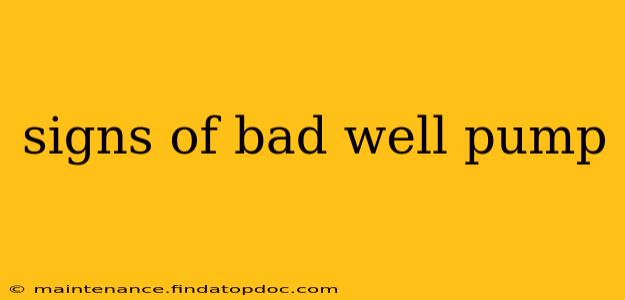A well pump is a crucial component of any home with a private well, providing the essential water supply for daily life. When this critical system fails, the consequences can be significant, leading to inconvenience and potential health concerns. Knowing the telltale signs of a failing well pump is crucial for preventative maintenance and timely repairs. This guide will cover the most common indicators that your well pump may be on its way out and what you can do about it.
1. No Water at All: The Most Obvious Sign
The most glaring sign of a failing well pump is the complete absence of water. This indicates a severe problem, possibly a completely failed pump motor or a problem with the power supply. Before calling a well pump repair professional, check your breaker box to ensure the pump's circuit breaker hasn't tripped. If the breaker is tripped and resets, there might be an electrical fault in the pump itself. If it trips immediately upon reset, DO NOT continue to reset it; call a professional immediately.
2. Low Water Pressure: A Gradual Decline
Experiencing weak water pressure, particularly during peak usage times, is another significant warning sign. This gradual decrease in water pressure suggests the pump may be struggling to keep up with demand, potentially due to wear and tear, mineral buildup, or a failing pump motor. Low pressure could also indicate issues within the well itself, such as a reduced water level.
3. Unusual Noises from the Well Pump: Grinding, Humming, or Gurgling
A well pump should operate relatively quietly. If you hear unusual noises emanating from your well pump, such as grinding, humming, or gurgling sounds, it’s a clear sign that something is amiss. These sounds usually signify mechanical problems within the pump, potentially indicating worn bearings, a failing motor, or cavitation (the formation of vapor bubbles in the pump). Immediate investigation is advised.
4. Pump Runs Continuously or Cycles Frequently: Overworking the System
A well pump that runs continuously or cycles on and off frequently without delivering sufficient water is another cause for concern. Constant running indicates a potential leak in the system, while frequent cycling may point towards a problem with the pressure switch or a reduced water level in the well.
5. Water Discoloration or Odor: Contamination Issues
While not always directly related to the pump itself, discolored or foul-smelling water can indirectly signal a problem. Contamination can indicate a failure in the well casing or plumbing, leading to sediment or bacteria entering the water supply. While the pump isn’t necessarily broken, this problem needs immediate attention to prevent health risks.
6. Reduced Water Flow: Not Enough Water Delivered
Reduced water flow, even with normal pressure, is an often overlooked problem. This can suggest a problem with the pump's impeller, its ability to move the water, or a restriction in the well's piping.
7. Frequent Pump Failures: A Recurring Issue
If your well pump has failed multiple times within a short period, it may indicate a deeper problem with the system's overall design or components. It might point to issues with the wiring, pressure tank, or other related parts. A professional assessment is crucial to prevent ongoing breakdowns.
What to Do If You Suspect a Problem:
If you notice any of these signs, it's essential to contact a qualified well pump professional for an inspection and repair or replacement as needed. Delaying repairs can lead to more extensive damage, higher repair costs, and potentially serious water supply disruptions. Regular maintenance, such as yearly inspections, can help prevent many of these problems from arising. Remember, a properly functioning well pump is crucial for your home's water supply and overall well-being.
